Class Text Classification Model Comparison and Selection
Way better!
df['post'].apply(lambda x: len(x.split(' '))).sum()3421180
After text cleaning and removing stop words, we have only over 3 million words to work with!
After splitting the data set, the next steps includes feature engineering. We will convert our text documents to a matrix of token counts (CountVectorizer), then transform a count matrix to a normalized tf-idf representation (tf-idf transformer). After that, we train several classifiers from
X = df.posty = df.tagsX_train, X_test, y_train, y_test = train_test_split(X, y, test_size=0.3, random_state = 42)
Naive Bayes Classifier for Multinomial Models
After we have our features, we can train a classifier to try to predict the tag of a post. We will start with a Naive Bayes
scikit-learn includes several variants of this classifier; the one most suitable for text is the multinomial variant.To make the vectorizer => transformer => classifier easier to work with, we will use Pipeline class in Scilkit-Learn that behaves like a compound classifier.


We achieved 74% accuracy.
Linear Support Vector Machine
Linear Support Vector Machine is widely regarded as one of the best text classification algorithms.

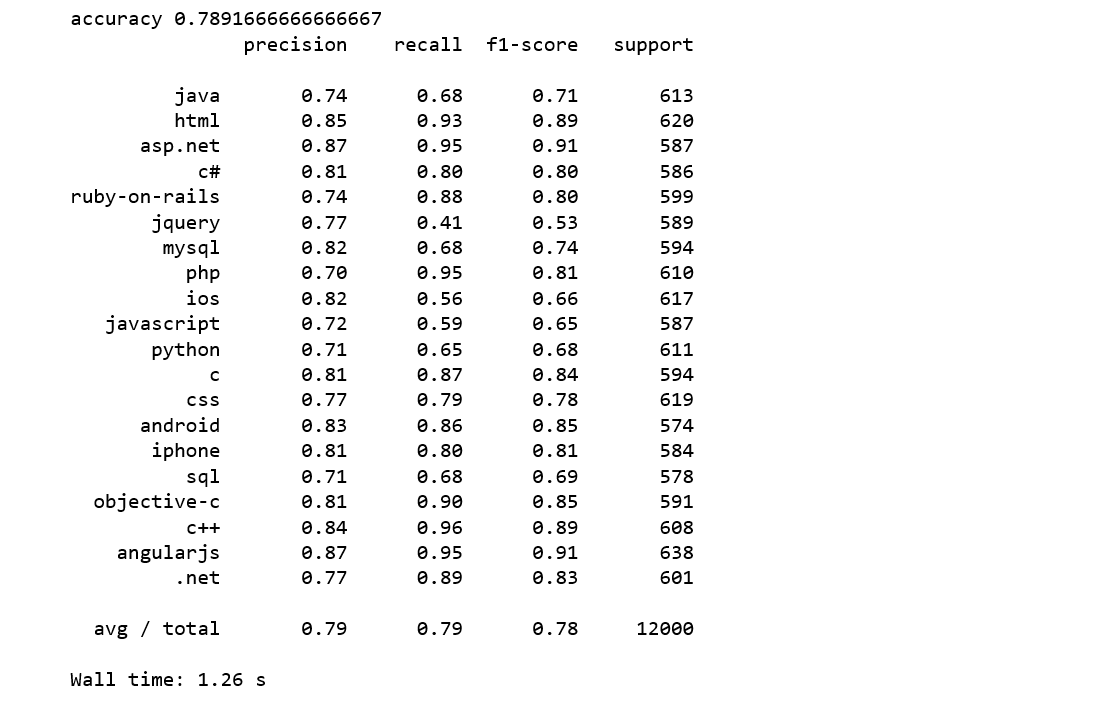
We achieve a higher accuracy score of 79% which is 5% improvement over Naive Bayes.
Logistic Regression
Logistic regression is a simple and easy to understand classification algorithm, and Logistic regression can be easily generalized to multiple classes.

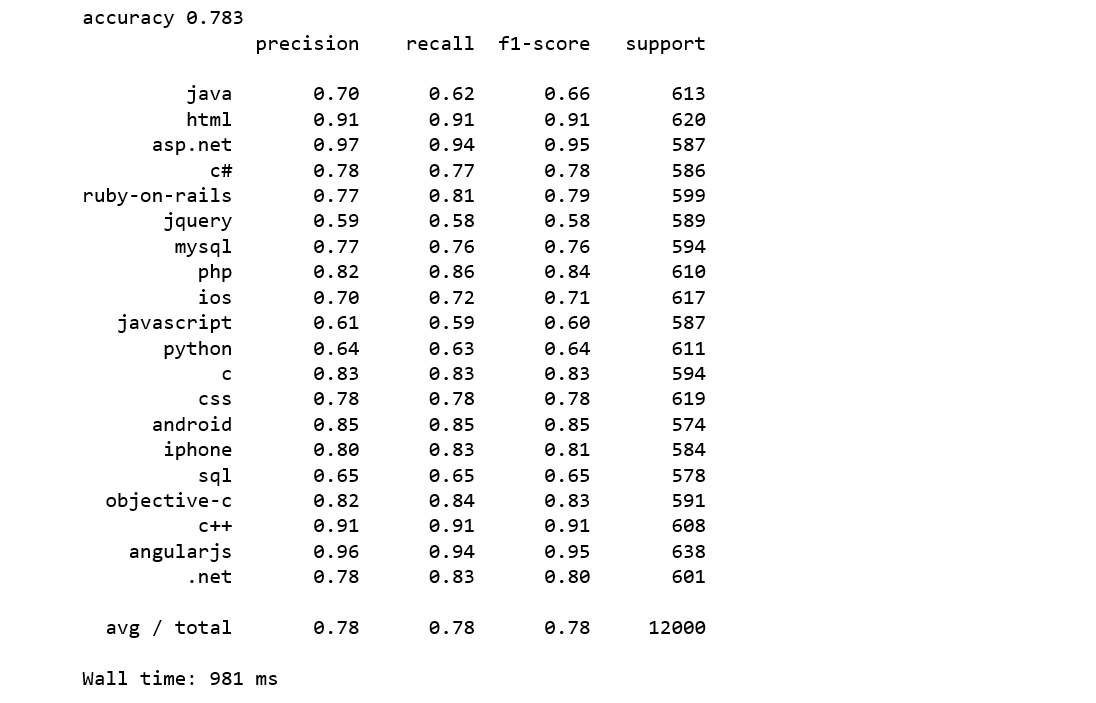
We achieve an accuracy score of 78% which is 4% higher than Naive Bayes and 1% lower than SVM.
As you can see, following some very basic steps and using a simple linear model, we were able to reach as high as an 79% accuracy on this multi-class text classification data set.
Using the same data set, we are going to try some advanced techniques such as word embedding and neural networks.
Now, let’s try some complex features than just simply counting words.
Word2vec and Logistic Regression
Word2vec, like doc2vec, belongs to the text preprocessing phase. Specifically, to the part that transforms a text into a row of numbers. Word2vec is a type of mapping that allows words with similar meaning to have similar vector representation.
The idea behind Word2vec is rather simple: we want to use the surrounding words to represent the target words with a Neural Network whose hidden layer encodes the word representation.
First we load a word2vec model. It has been pre-trained by Google on a 100 billion word Google News corpus.
from gensim.models import Word2Vec
wv = gensim.models.KeyedVectors.load_word2vec_format("GoogleNews-vectors-negative300.bin.gz", binary=True)wv.init_sims(replace=True)We may want to explore some vocabularies.
from itertools import islicelist(islice(wv.vocab, 13030, 13050))

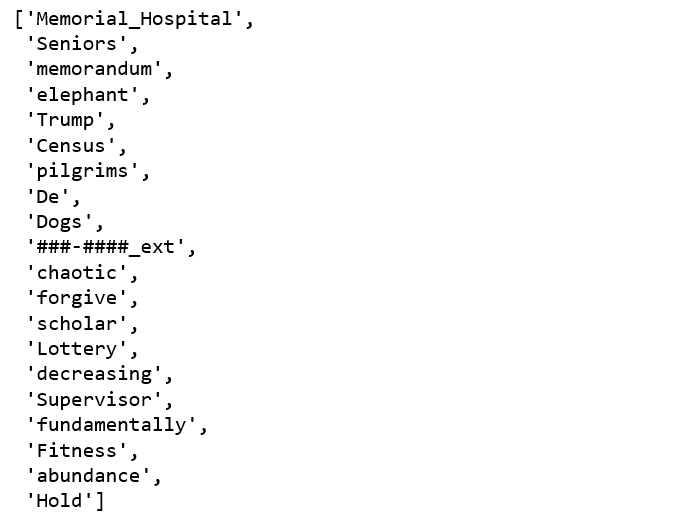
BOW based approaches that includes averaging, summation, weighted addition. The common way is to average the two word vectors. Therefore, we will follow the most common way.
We will tokenize the text and apply the tokenization to “post” column, and apply word vector averaging to tokenized text.
Its time to see how logistic regression classifiers performs on these word-averaging document features.
from sklearn.linear_model import LogisticRegressionlogreg = LogisticRegression(n_jobs=1, C=1e5)logreg = logreg.fit(X_train_word_average, train['tags'])y_pred = logreg.predict(X_test_word_average)print('accuracy %s' % accuracy_score(y_pred, test.tags))print(classification_report(test.tags, y_pred,target_names=my_tags))
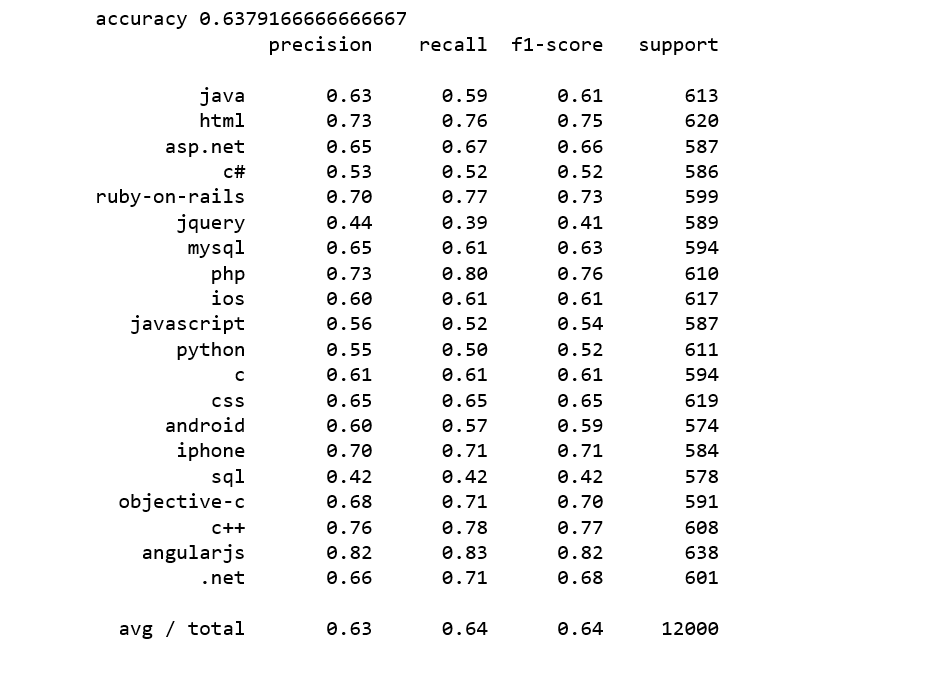
It was disappointing, worst we have seen so far.
Doc2vec and Logistic Regression
The same idea of word2vec can be extended to documents where instead of learning feature representations for words, we learn it for sentences or documents. To get a general idea of a word2vec, think of it as a mathematical average of the word vector representations of all the words in the document. Doc2Vec extends the idea of word2vec, however words can only capture so much, there are times when we need relationships between documents and not just words.
The way to train doc2vec model for our Stack Overflow questions and tags data is very similar with when we train Multi-Class Text Classification with Doc2vec and Logistic Regression.
First, we label the sentences. Gensim’s Doc2Vec implementation requires each document/paragraph to have a label associated with it. and we do this by using the TaggedDocument method. The format will be “TRAIN_i” or “TEST_i” where “i” is a dummy index of the post.
According to Gensim doc2vec tutorial, its doc2vec class was trained on the entire data, and we will do the same. Let’s have a look what the tagged document looks like:
all_data[:2]


When training the doc2vec, we will vary the following parameters:
dm=0, distributed bag of words (DBOW) is used.vector_size=300, 300 vector dimensional feature vectors.negative=5, specifies how many “noise words” should be drawn.min_count=1, ignores all words with total frequency lower than this.alpha=0.065, the initial learning rate.
We initialize the model and train for 30 epochs.
Next, we get vectors from trained doc2vec model.
Finally, we get a logistic regression model trained by the doc2vec features.
logreg = LogisticRegression(n_jobs=1, C=1e5)logreg.fit(train_vectors_dbow, y_train)logreg = logreg.fit(train_vectors_dbow, y_train)y_pred = logreg.predict(test_vectors_dbow)print('accuracy %s' % accuracy_score(y_pred, y_test))print(classification_report(y_test, y_pred,target_names=my_tags))
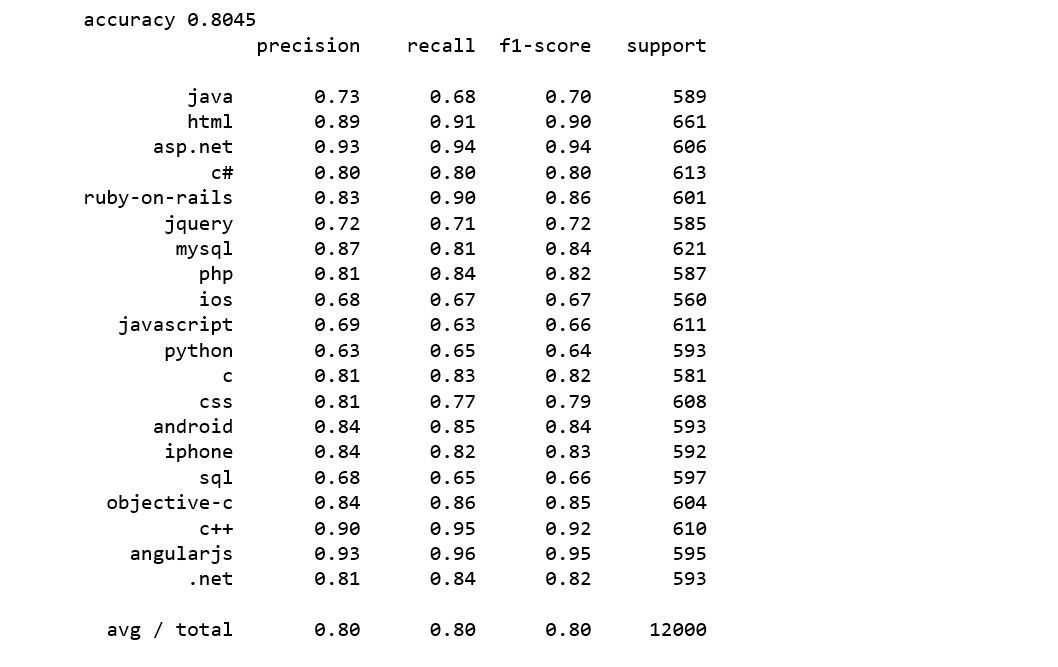
We achieve an accuracy score of 80% which is 1% higher than SVM.
BOW with Keras
Finally, we are going to do a text classification with Keras which is a Python Deep Learning library.
The following code were largely taken from a Google workshop. The process is like this:
- Separate the data into training and test sets.
- Use
tokenizermethods to count the unique words in our vocabulary and assign each of those words to indices. - Calling
fit_on_texts()automatically creates a word index lookup of our vocabulary. - We limit our vocabulary to the top words by passing a
num_wordsparam to the tokenizer. - With our tokenizer, we can now use the
texts_to_matrixmethod to create the training data that we’ll pass our model. - We feed a one-hot vector to our model.
- After we transform our features and labels in a format Keras can read, we are ready to build our text classification model.
- When we build our model, all we need to do is tell Keras the shape of our input data, output data, and the type of each layer. keras will look after the rest.
- When training the model, we’ll call the
fit()method, pass it our training data and labels, batch size and epochs.
